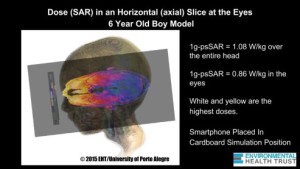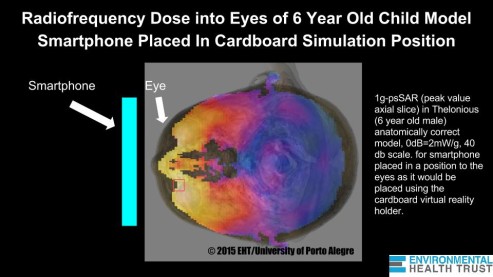Stop Untested Microwave Radiation Of Children’s Brains And Eyes EHT Scientists Urge Google
Scientific imaging shows how children absorb radiation from Smartphones in Virtual reality cardboard positions.
Environmental Health Trust (EHT) scientists are calling on Google to stop the spread into schools of wireless virtual reality system Global Expeditions Pioneer Program where middle-school children hold a cell phone encased in a cardboard box in front of their eyes to take virtual expeditions to Mars, the moon, and other special places.
“Two-way microwave radiation transceivers, in the form of Smartphones, should not be used directly in front of children’s eyes and brains,” cautions University of Utah Distinguished Prof. Om Gandhi, who is one of the original developers of testing to evaluate wireless radiation from cellphones and is a Senior Advisor to EHT.
Prof. Gandhi added, “We have never tested microwave radiating devices directly in front of the young developing eye. The absence of proof of harm at this point does not mean that we have evidence of safety.”
“We want to know why is Google encouraging young children to employ a technology that has never been tested for their use when Samsung has a similar system that explicitly advises that no child under the age of 13 should be using it,” asks Devra Davis, President of EHT, and Visiting Professor of Ondokuz Mayis University Medical School and The Hebrew University Hadassah Medical Center.
EHT collaborating scientist, Professor Claudio Fernandez from the federal university of Canoas, Brazil, used cutting-edge modeling and found that radiation from the virtual reality applied wireless phones could easily exceed levels tested on adults.
“When we began to model cellphone exposures in the brains of toddlers and young children, I never imagined we would see these sorts of uses with devices placed directly in front of the eye and close to the brain,” noted Professor Claudio Fernandez, whose research employs anatomically-based models of children to modeling cellphone absorption.
Dr. Mary Redmayne, a researcher at Monash University in Australia and EHT Advisor, adds that “Children’s brains are not fully myelinated and eyes absorb radiation readily due to their high water content. Placing a two-way microwave radiating device directly in front of young eyes is not a wise choice in my opinion.”
In the case of the Google Expedition Wireless Virtual Reality System, a smartphone is used in a vertical position directly in front of the eyes of children. Please note the following facts about virtual reality and cellphone radiation:
- OTHER COMPANIES DO INFORM USERS OF THE SAFETY RISKS OF VIRTUAL REALITY: Samsung, for example, states that “The Gear VR headset should not be used by children under the age of 13, as these children may be at increased health and safety risk.” Samsung then has a long list of “General Instructions and Precautions” stating that “Warning! You should always follow these instructions and observe these precautions while using the Gear VR headset to reduced the risk of injury or discomfort.” Precautions listed include: Use for only a few minutes at a time at first, Do not use when you are tired, are under emotional stress or anxiety, or when suffering from cold, flu, headaches, migraines, or earaches, as this can increase your susceptibility to adverse symptoms. Samsung cautions that “Some people may have severe dizziness, seizures, epileptic seizures or blackouts triggered by light flashes or patterns”.
- LACK OF SAFETY TESTING: Mobile phones have never been evaluated for their impact on the young developing eye.
- INCREASED CATARACTS AFTER HIGH EXPOSURES: Several scientific investigations have shown that cataracts among humans and laboratory animals occur as a result of eye exposure to microwave/radiofrequency radiation. The eyes are highly vulnerable to radiation damage because they contain few blood vessels and have no way to cool off.
- 19 YEAR OLD TESTING DOES NOT ACCOUNT FOR CHILDREN’S UNIQUE MAKEUP: Based on standards developed in 1997, phones are tested at a distance of 5-10 mm away from a large adult male skull and up to an inch away from the male hip for periods of 6 minutes to 30 minutes. Children have thinner skulls, smaller heads and a higher water content in brain tissues. The American Academy of Pediatrics has called on the government to update these outdated approaches.
- CHILDREN ABSORB MORE RADIATION THAN ADULTS: Studies just published by the Porto Alegre EHT collaboration find that children absorb more radiation than can legally be absorbed into adults, confirming two decades of research.
- IMAGING OF CELL PHONES SIMULATING THESE POSITIONS SHOWS RADIATION DOSES: Preliminary imaging with the cellphone close to the eye and brain of a child shows that such positions result in higher microwave radiation exposures to the eyes. This imaging also shows radiation dose into the brain. These simulations employed an anatomically based model of a six year old and generated estimates of how the young brain absorbs cell phone radiation. Researchers are using this state of the art research to understand the radiofrequency dose in children as shown in this recent IEEE Access publication on children’s higher absorption.
- STUDENTS AND STAFF ARE UNAWARE OF SAFETY INSTRUCTIONS: All smartphones today come with specific manufacturer’s safety instructions about “as-tested distance” to meet FCC regulations. This language is often buried in fine print instructions hidden deep in the manual. Children’s handling of transmitting cell phones in a classroom could result in the positioning the cell phones unsafely against their body as most children and staff are unaware of these safety instructions. Visit the websitewww.showthefineprint.org for specific advisories on different phone models. Please see the image below showing a wireless router positioned near school children.
- INCREASED CANCER RISK: The World Health Organization’s International Agency for Research on Cancer (IARC) classifies RF radiation as a Class 2B Carcinogen, a “possible human carcinogen”. The IARC issued theirMonograph in April 2013 detailing the basis of the classification, which was in part based on research showing an association between long-term cellphone users (corresponding to about 30 minutes per day for 10 years) and increased brain cancer.
- INCREASED CANCER RISK TO HIGHEST EXPOSED AREAS: Recent research indicates an association between location of tumor development and areas of the brain that are higher exposed to cell phone radiation due to the person favoring a particular side of the head to hold their phone up against. Tumors were more often located primarily in the part of the brain receiving maximum exposure. Additionally, scientists are now exploring recent case studies of young woman developing unusually located breast cancer tumors directly underneath the place the women placed their cell phone in their bra.
- BRAIN DAMAGE AND ALTERED BRAIN FUNCTIONING AFTER EXPOSURE: Yale University research found prenatally exposed pups had impaired memory, increased hyperactivity and altered brains- consistent with a growing literature. Experimental research indicates damaged and reduced brain cells after chronic exposure. NIH research found just 50 minutes of a wireless transmitting device (cell phone) next to the brain increases glucose in the part of the brain most exposed. Preliminary 3G and 4G research has shown that non-thermal levels of this radiation alter the brain’s electrical activity.
- GOVERNMENT GUIDELINES DO NOT PROVIDE ADEQUATE PROTECTION: A growing body of research points to serious adverse health effects from exposures to radiofrequency radiation at levels far below the thermally based government guidelines in place now, which means that even at the “as tested” distance, cellphone radiation could harm children’s developing immune, reproductive and neurological systems.
- GOVERNMENTS ENACTING PROTECTIVE POLICY WORLDWIDE: In light of the state of science and the lack of safety assurances, several countries such as India, France,Belgium and Cyprusrecommend reducing children’s exposure to cell phone radiation. Such policies are in sharp contrast to the use of a wireless virtual reality system in US classrooms. This new technology increases children’s cell phone radiation exposure to the head, particularly the eyes and brain.
RECOMMENDATIONS: In light of this scientific information, the Environmental Health Trust recommends that schools forgo experimenting on their students with such wireless virtual reality systems and choose safe radiation-free non-wireless technology for classroom curriculum. Environmental Health Trust recommends Google halt the introduction of Google Expeditions Kits into Schools as no scientific evidence exists which demonstrates that such radiofrequency doses to children’s eyes are safe. It is EHT’s opinion that a virtual reality system that places a microwave emitting cell phone directly in front of a child’s eyes and brain could pose a serious health risk to students.
BACKGROUND
Googles Expeditions Pioneer Program pilot provides a kit to schools which includes, ASUS smartphones, a wireless tablet for the teacher to act as the tour director, a wireless internet router, allowing Expeditions to run without an internet connection and Google Cardboard headsets. Google is currently providing these kits for free to schools across the country.
Read a Leter From A concerned Mother My Son Came Home To Tell Me About The Google Pioneer Program at School: 12/2015 Letter From A Mother in Montgomery County Schools
Information on Google Pioneer Program
It is our understanding that for the Google Pioneer Program being used in schools a Zenfone 2 is used in each cardboard holder placed against the eyes Please note the following fine print instructions in the safety manual of the Zenfone 2:
- “To reduce exposure to RF energy, use a hands-free accessory or other similar option to keep this device away from your head and body.”
- “Carry this device at least 10 mm away from your body to ensure exposure levels remain at or below the as-tested levels.”
- “SAR is measured with this device at a separation of 1.5 cm to the body, while transmitting at the highest certified output power level in all frequency bands of this device. Use of other accessories which contain metals may not ensure compliance with ICNIRP exposure guidelines.”
- Read these instructions here.
According to the Google Pioneer Website the following safety instructions are noted:
- If your viewer is made out of cardboard, make sure that your audiences understand the limitations of the material: not water-resistant, potentially combustible (especially if lenses are facing a strong light source) Read it herehttp://static.googleusercontent.com/media/www.google.com/en//get/cardboard/downloads/wwgc_best_practices.pdf,
- Take frequent breaks while using Cardboard. If you experience nausea, discomfort, eye strain, or disorientation, immediately discontinue using Cardboard. Read it herehttp://www.google.com/get/cardboard/product-safety/
- If you include magnets, retain the messaging that the viewer contains magnets that may affect pacemakers.



No comments:
Post a Comment